Content Theory: Maslow's Hierarchy of Needs in Organizations
VerifiedAdded on 2021/02/08
|11
|4343
|68
Report
AI Summary
This report examines a content theory of motivation, specifically focusing on Abraham Maslow's hierarchy of needs, and its application in organizational settings. It begins by defining motivation and then delves into Maslow's theory, which posits that individuals are driven to fulfill a hierarchy of needs, from basic physiological requirements to self-actualization. The report explores the benefits of applying this theory, such as increased employee satisfaction, productivity, and organizational growth, citing examples from local, national, and international companies like Tru Smoothie, Amazon, Google, Apple, Asda, and Tesco. It also discusses the limitations of the theory, including the assumption that all employees and situations are alike and the potential for oversimplification. The report concludes by summarizing the key points and emphasizing the importance of understanding and addressing employee needs to foster a motivated and effective workforce, which is crucial for organizational success.
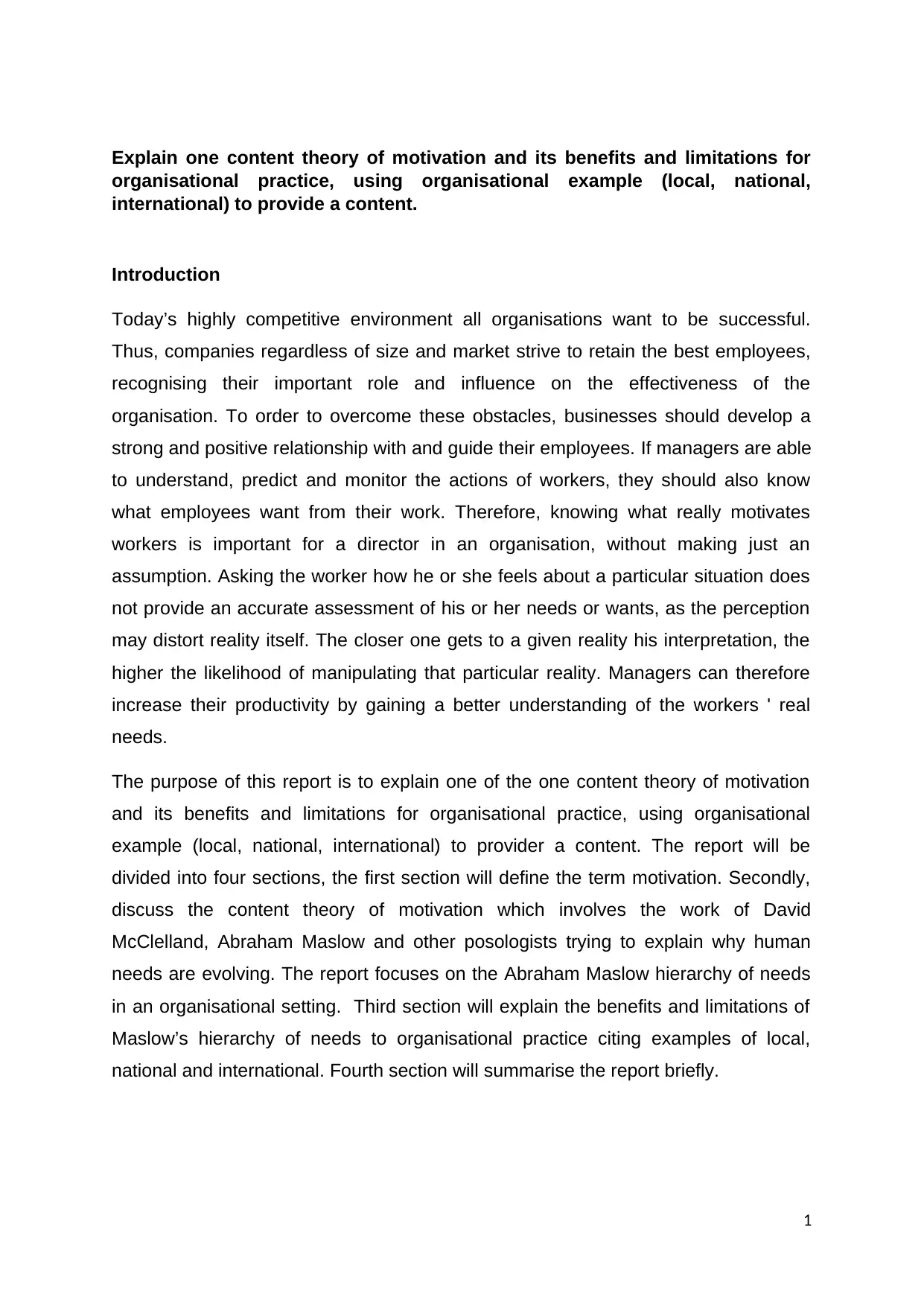
Explain one content theory of motivation and its benefits and limitations for
organisational practice, using organisational example (local, national,
international) to provide a content.
Introduction
Today’s highly competitive environment all organisations want to be successful.
Thus, companies regardless of size and market strive to retain the best employees,
recognising their important role and influence on the effectiveness of the
organisation. To order to overcome these obstacles, businesses should develop a
strong and positive relationship with and guide their employees. If managers are able
to understand, predict and monitor the actions of workers, they should also know
what employees want from their work. Therefore, knowing what really motivates
workers is important for a director in an organisation, without making just an
assumption. Asking the worker how he or she feels about a particular situation does
not provide an accurate assessment of his or her needs or wants, as the perception
may distort reality itself. The closer one gets to a given reality his interpretation, the
higher the likelihood of manipulating that particular reality. Managers can therefore
increase their productivity by gaining a better understanding of the workers ' real
needs.
The purpose of this report is to explain one of the one content theory of motivation
and its benefits and limitations for organisational practice, using organisational
example (local, national, international) to provider a content. The report will be
divided into four sections, the first section will define the term motivation. Secondly,
discuss the content theory of motivation which involves the work of David
McClelland, Abraham Maslow and other posologists trying to explain why human
needs are evolving. The report focuses on the Abraham Maslow hierarchy of needs
in an organisational setting. Third section will explain the benefits and limitations of
Maslow’s hierarchy of needs to organisational practice citing examples of local,
national and international. Fourth section will summarise the report briefly.
1
organisational practice, using organisational example (local, national,
international) to provide a content.
Introduction
Today’s highly competitive environment all organisations want to be successful.
Thus, companies regardless of size and market strive to retain the best employees,
recognising their important role and influence on the effectiveness of the
organisation. To order to overcome these obstacles, businesses should develop a
strong and positive relationship with and guide their employees. If managers are able
to understand, predict and monitor the actions of workers, they should also know
what employees want from their work. Therefore, knowing what really motivates
workers is important for a director in an organisation, without making just an
assumption. Asking the worker how he or she feels about a particular situation does
not provide an accurate assessment of his or her needs or wants, as the perception
may distort reality itself. The closer one gets to a given reality his interpretation, the
higher the likelihood of manipulating that particular reality. Managers can therefore
increase their productivity by gaining a better understanding of the workers ' real
needs.
The purpose of this report is to explain one of the one content theory of motivation
and its benefits and limitations for organisational practice, using organisational
example (local, national, international) to provider a content. The report will be
divided into four sections, the first section will define the term motivation. Secondly,
discuss the content theory of motivation which involves the work of David
McClelland, Abraham Maslow and other posologists trying to explain why human
needs are evolving. The report focuses on the Abraham Maslow hierarchy of needs
in an organisational setting. Third section will explain the benefits and limitations of
Maslow’s hierarchy of needs to organisational practice citing examples of local,
national and international. Fourth section will summarise the report briefly.
1
Paraphrase This Document
Need a fresh take? Get an instant paraphrase of this document with our AI Paraphraser
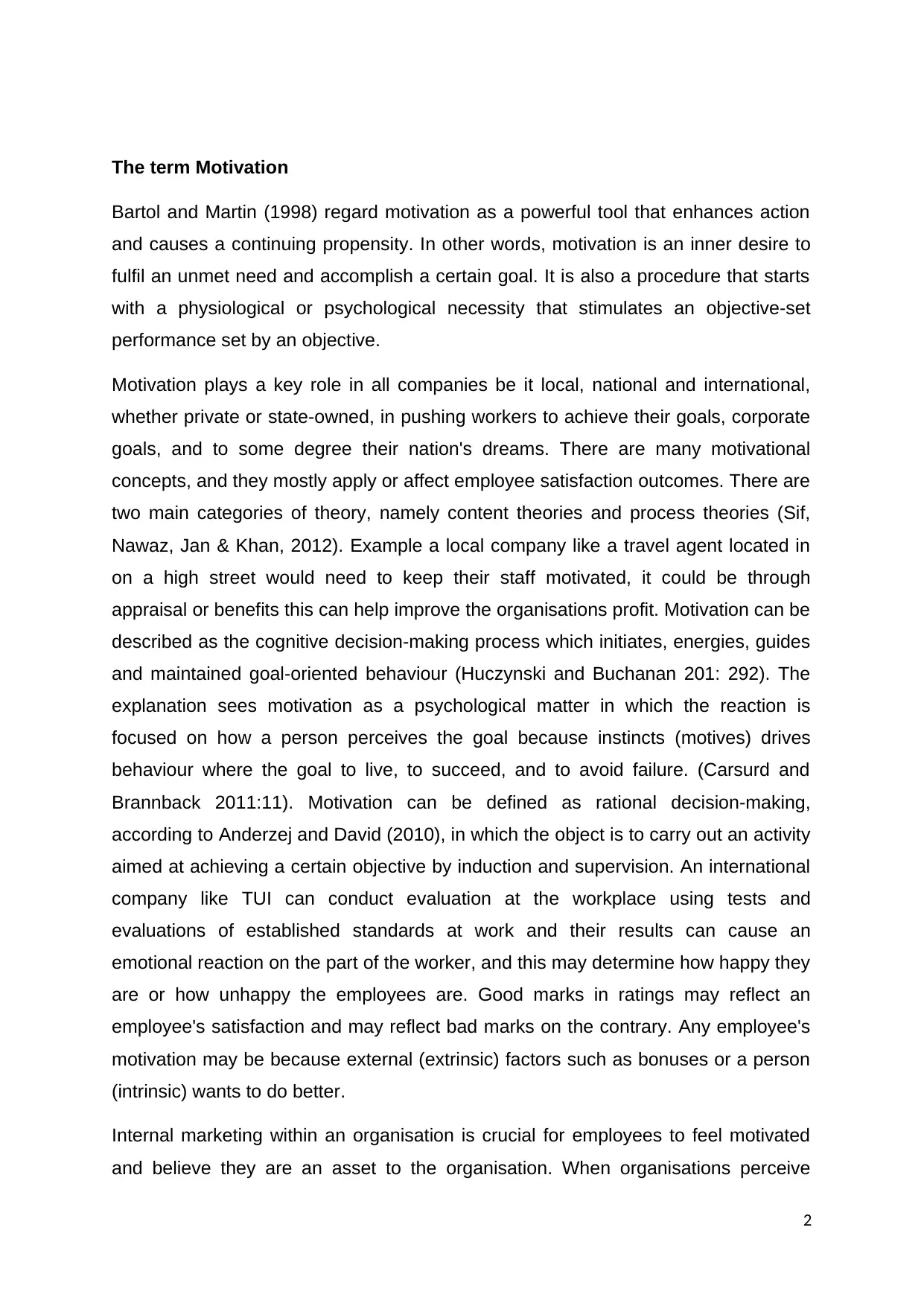
The term Motivation
Bartol and Martin (1998) regard motivation as a powerful tool that enhances action
and causes a continuing propensity. In other words, motivation is an inner desire to
fulfil an unmet need and accomplish a certain goal. It is also a procedure that starts
with a physiological or psychological necessity that stimulates an objective-set
performance set by an objective.
Motivation plays a key role in all companies be it local, national and international,
whether private or state-owned, in pushing workers to achieve their goals, corporate
goals, and to some degree their nation's dreams. There are many motivational
concepts, and they mostly apply or affect employee satisfaction outcomes. There are
two main categories of theory, namely content theories and process theories (Sif,
Nawaz, Jan & Khan, 2012). Example a local company like a travel agent located in
on a high street would need to keep their staff motivated, it could be through
appraisal or benefits this can help improve the organisations profit. Motivation can be
described as the cognitive decision-making process which initiates, energies, guides
and maintained goal-oriented behaviour (Huczynski and Buchanan 201: 292). The
explanation sees motivation as a psychological matter in which the reaction is
focused on how a person perceives the goal because instincts (motives) drives
behaviour where the goal to live, to succeed, and to avoid failure. (Carsurd and
Brannback 2011:11). Motivation can be defined as rational decision-making,
according to Anderzej and David (2010), in which the object is to carry out an activity
aimed at achieving a certain objective by induction and supervision. An international
company like TUI can conduct evaluation at the workplace using tests and
evaluations of established standards at work and their results can cause an
emotional reaction on the part of the worker, and this may determine how happy they
are or how unhappy the employees are. Good marks in ratings may reflect an
employee's satisfaction and may reflect bad marks on the contrary. Any employee's
motivation may be because external (extrinsic) factors such as bonuses or a person
(intrinsic) wants to do better.
Internal marketing within an organisation is crucial for employees to feel motivated
and believe they are an asset to the organisation. When organisations perceive
2
Bartol and Martin (1998) regard motivation as a powerful tool that enhances action
and causes a continuing propensity. In other words, motivation is an inner desire to
fulfil an unmet need and accomplish a certain goal. It is also a procedure that starts
with a physiological or psychological necessity that stimulates an objective-set
performance set by an objective.
Motivation plays a key role in all companies be it local, national and international,
whether private or state-owned, in pushing workers to achieve their goals, corporate
goals, and to some degree their nation's dreams. There are many motivational
concepts, and they mostly apply or affect employee satisfaction outcomes. There are
two main categories of theory, namely content theories and process theories (Sif,
Nawaz, Jan & Khan, 2012). Example a local company like a travel agent located in
on a high street would need to keep their staff motivated, it could be through
appraisal or benefits this can help improve the organisations profit. Motivation can be
described as the cognitive decision-making process which initiates, energies, guides
and maintained goal-oriented behaviour (Huczynski and Buchanan 201: 292). The
explanation sees motivation as a psychological matter in which the reaction is
focused on how a person perceives the goal because instincts (motives) drives
behaviour where the goal to live, to succeed, and to avoid failure. (Carsurd and
Brannback 2011:11). Motivation can be defined as rational decision-making,
according to Anderzej and David (2010), in which the object is to carry out an activity
aimed at achieving a certain objective by induction and supervision. An international
company like TUI can conduct evaluation at the workplace using tests and
evaluations of established standards at work and their results can cause an
emotional reaction on the part of the worker, and this may determine how happy they
are or how unhappy the employees are. Good marks in ratings may reflect an
employee's satisfaction and may reflect bad marks on the contrary. Any employee's
motivation may be because external (extrinsic) factors such as bonuses or a person
(intrinsic) wants to do better.
Internal marketing within an organisation is crucial for employees to feel motivated
and believe they are an asset to the organisation. When organisations perceive
2
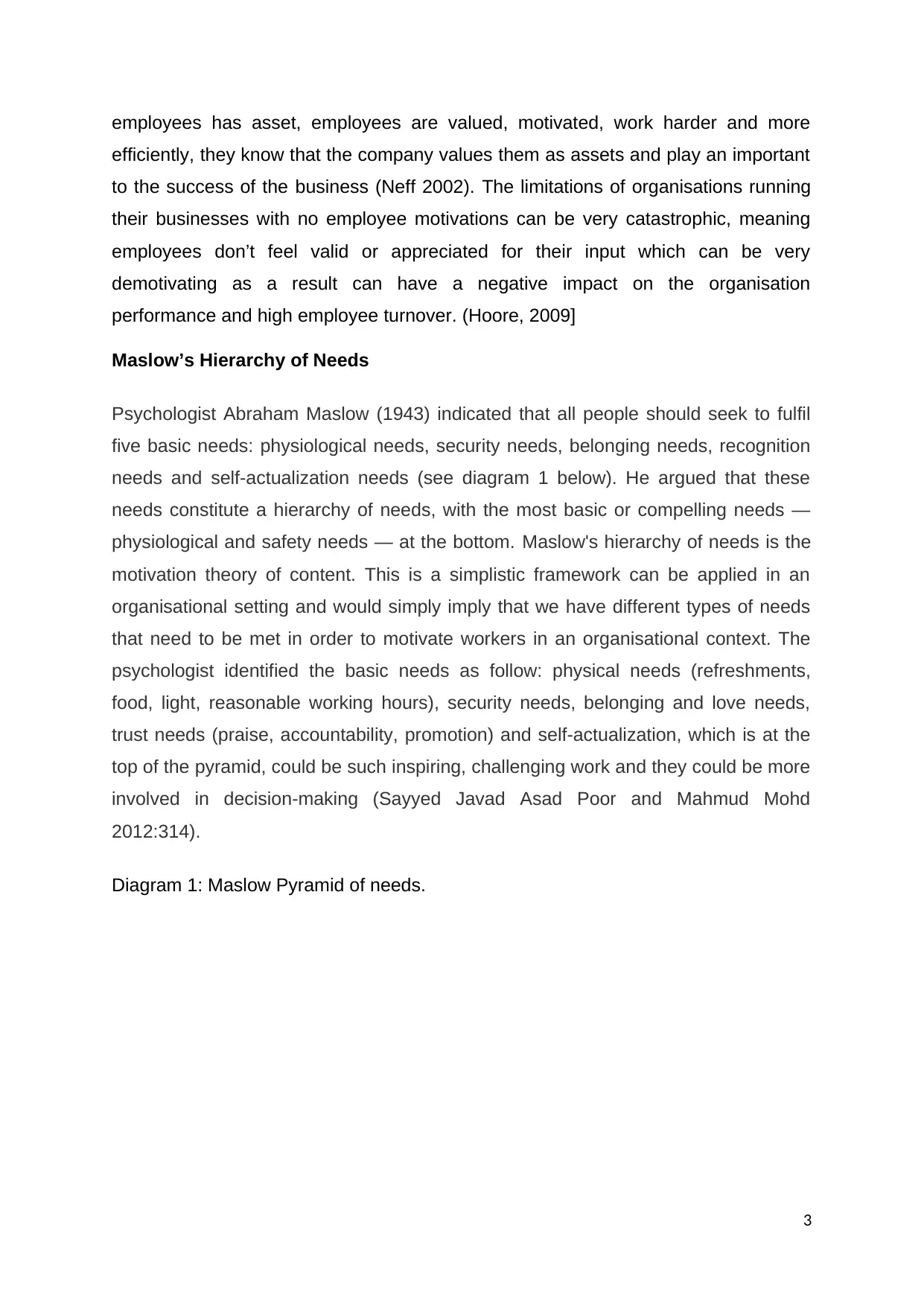
employees has asset, employees are valued, motivated, work harder and more
efficiently, they know that the company values them as assets and play an important
to the success of the business (Neff 2002). The limitations of organisations running
their businesses with no employee motivations can be very catastrophic, meaning
employees don’t feel valid or appreciated for their input which can be very
demotivating as a result can have a negative impact on the organisation
performance and high employee turnover. (Hoore, 2009]
Maslow’s Hierarchy of Needs
Psychologist Abraham Maslow (1943) indicated that all people should seek to fulfil
five basic needs: physiological needs, security needs, belonging needs, recognition
needs and self-actualization needs (see diagram 1 below). He argued that these
needs constitute a hierarchy of needs, with the most basic or compelling needs —
physiological and safety needs — at the bottom. Maslow's hierarchy of needs is the
motivation theory of content. This is a simplistic framework can be applied in an
organisational setting and would simply imply that we have different types of needs
that need to be met in order to motivate workers in an organisational context. The
psychologist identified the basic needs as follow: physical needs (refreshments,
food, light, reasonable working hours), security needs, belonging and love needs,
trust needs (praise, accountability, promotion) and self-actualization, which is at the
top of the pyramid, could be such inspiring, challenging work and they could be more
involved in decision-making (Sayyed Javad Asad Poor and Mahmud Mohd
2012:314).
Diagram 1: Maslow Pyramid of needs.
3
efficiently, they know that the company values them as assets and play an important
to the success of the business (Neff 2002). The limitations of organisations running
their businesses with no employee motivations can be very catastrophic, meaning
employees don’t feel valid or appreciated for their input which can be very
demotivating as a result can have a negative impact on the organisation
performance and high employee turnover. (Hoore, 2009]
Maslow’s Hierarchy of Needs
Psychologist Abraham Maslow (1943) indicated that all people should seek to fulfil
five basic needs: physiological needs, security needs, belonging needs, recognition
needs and self-actualization needs (see diagram 1 below). He argued that these
needs constitute a hierarchy of needs, with the most basic or compelling needs —
physiological and safety needs — at the bottom. Maslow's hierarchy of needs is the
motivation theory of content. This is a simplistic framework can be applied in an
organisational setting and would simply imply that we have different types of needs
that need to be met in order to motivate workers in an organisational context. The
psychologist identified the basic needs as follow: physical needs (refreshments,
food, light, reasonable working hours), security needs, belonging and love needs,
trust needs (praise, accountability, promotion) and self-actualization, which is at the
top of the pyramid, could be such inspiring, challenging work and they could be more
involved in decision-making (Sayyed Javad Asad Poor and Mahmud Mohd
2012:314).
Diagram 1: Maslow Pyramid of needs.
3
⊘ This is a preview!⊘
Do you want full access?
Subscribe today to unlock all pages.

Trusted by 1+ million students worldwide
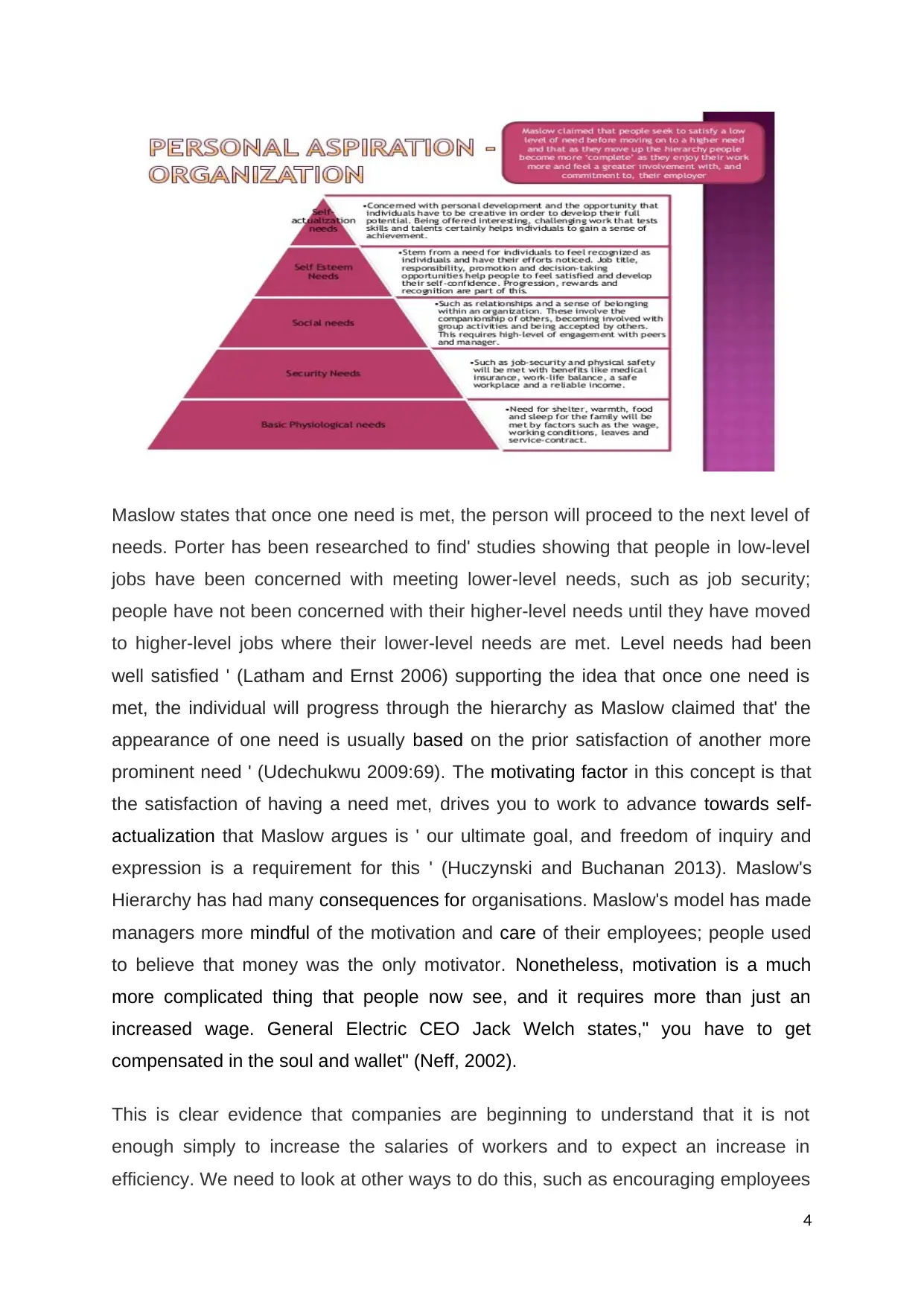
Maslow states that once one need is met, the person will proceed to the next level of
needs. Porter has been researched to find' studies showing that people in low-level
jobs have been concerned with meeting lower-level needs, such as job security;
people have not been concerned with their higher-level needs until they have moved
to higher-level jobs where their lower-level needs are met. Level needs had been
well satisfied ' (Latham and Ernst 2006) supporting the idea that once one need is
met, the individual will progress through the hierarchy as Maslow claimed that' the
appearance of one need is usually based on the prior satisfaction of another more
prominent need ' (Udechukwu 2009:69). The motivating factor in this concept is that
the satisfaction of having a need met, drives you to work to advance towards self-
actualization that Maslow argues is ' our ultimate goal, and freedom of inquiry and
expression is a requirement for this ' (Huczynski and Buchanan 2013). Maslow's
Hierarchy has had many consequences for organisations. Maslow's model has made
managers more mindful of the motivation and care of their employees; people used
to believe that money was the only motivator. Nonetheless, motivation is a much
more complicated thing that people now see, and it requires more than just an
increased wage. General Electric CEO Jack Welch states," you have to get
compensated in the soul and wallet" (Neff, 2002).
This is clear evidence that companies are beginning to understand that it is not
enough simply to increase the salaries of workers and to expect an increase in
efficiency. We need to look at other ways to do this, such as encouraging employees
4
needs. Porter has been researched to find' studies showing that people in low-level
jobs have been concerned with meeting lower-level needs, such as job security;
people have not been concerned with their higher-level needs until they have moved
to higher-level jobs where their lower-level needs are met. Level needs had been
well satisfied ' (Latham and Ernst 2006) supporting the idea that once one need is
met, the individual will progress through the hierarchy as Maslow claimed that' the
appearance of one need is usually based on the prior satisfaction of another more
prominent need ' (Udechukwu 2009:69). The motivating factor in this concept is that
the satisfaction of having a need met, drives you to work to advance towards self-
actualization that Maslow argues is ' our ultimate goal, and freedom of inquiry and
expression is a requirement for this ' (Huczynski and Buchanan 2013). Maslow's
Hierarchy has had many consequences for organisations. Maslow's model has made
managers more mindful of the motivation and care of their employees; people used
to believe that money was the only motivator. Nonetheless, motivation is a much
more complicated thing that people now see, and it requires more than just an
increased wage. General Electric CEO Jack Welch states," you have to get
compensated in the soul and wallet" (Neff, 2002).
This is clear evidence that companies are beginning to understand that it is not
enough simply to increase the salaries of workers and to expect an increase in
efficiency. We need to look at other ways to do this, such as encouraging employees
4
Paraphrase This Document
Need a fresh take? Get an instant paraphrase of this document with our AI Paraphraser
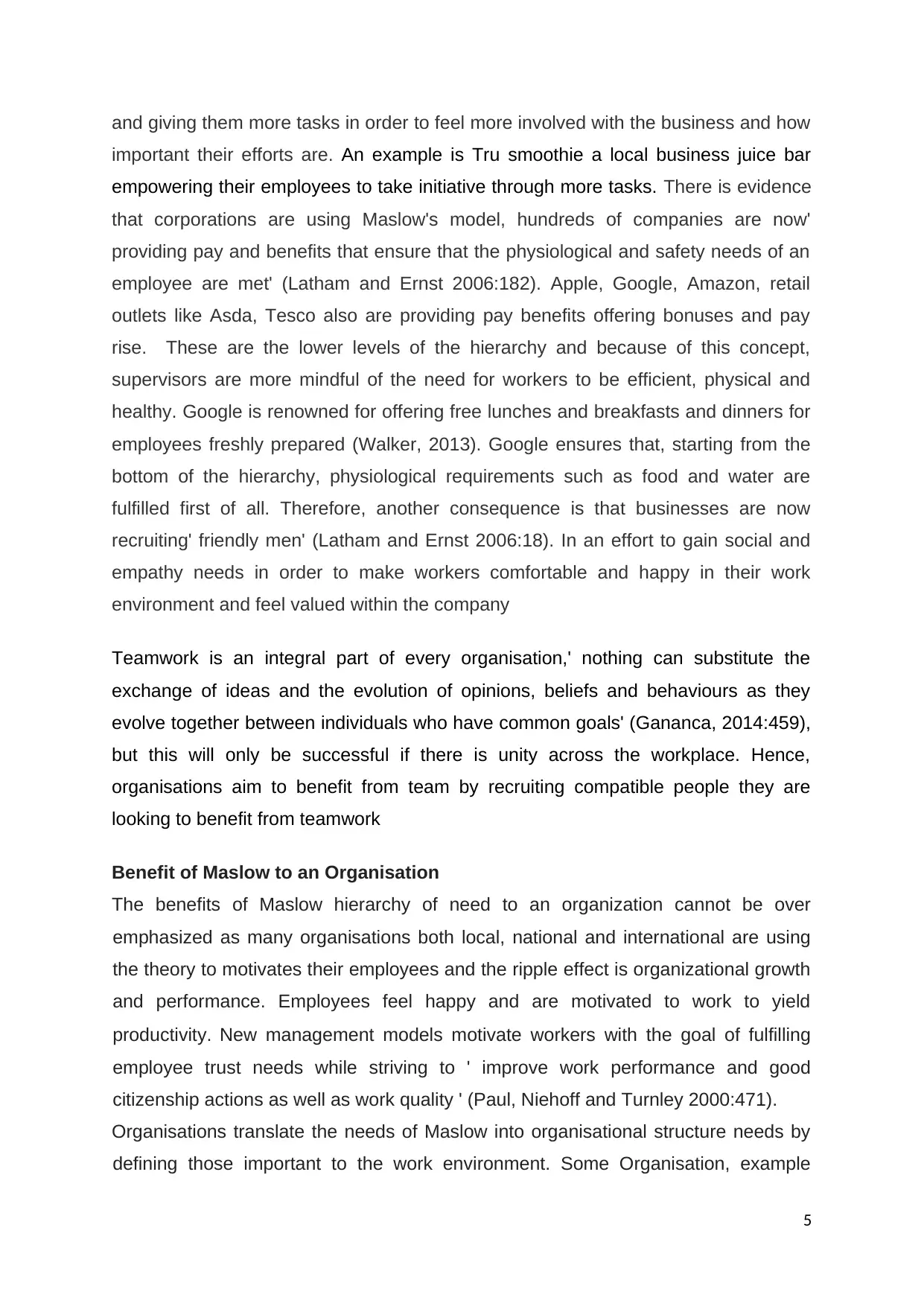
and giving them more tasks in order to feel more involved with the business and how
important their efforts are. An example is Tru smoothie a local business juice bar
empowering their employees to take initiative through more tasks. There is evidence
that corporations are using Maslow's model, hundreds of companies are now'
providing pay and benefits that ensure that the physiological and safety needs of an
employee are met' (Latham and Ernst 2006:182). Apple, Google, Amazon, retail
outlets like Asda, Tesco also are providing pay benefits offering bonuses and pay
rise. These are the lower levels of the hierarchy and because of this concept,
supervisors are more mindful of the need for workers to be efficient, physical and
healthy. Google is renowned for offering free lunches and breakfasts and dinners for
employees freshly prepared (Walker, 2013). Google ensures that, starting from the
bottom of the hierarchy, physiological requirements such as food and water are
fulfilled first of all. Therefore, another consequence is that businesses are now
recruiting' friendly men' (Latham and Ernst 2006:18). In an effort to gain social and
empathy needs in order to make workers comfortable and happy in their work
environment and feel valued within the company
Teamwork is an integral part of every organisation,' nothing can substitute the
exchange of ideas and the evolution of opinions, beliefs and behaviours as they
evolve together between individuals who have common goals' (Gananca, 2014:459),
but this will only be successful if there is unity across the workplace. Hence,
organisations aim to benefit from team by recruiting compatible people they are
looking to benefit from teamwork
Benefit of Maslow to an Organisation
The benefits of Maslow hierarchy of need to an organization cannot be over
emphasized as many organisations both local, national and international are using
the theory to motivates their employees and the ripple effect is organizational growth
and performance. Employees feel happy and are motivated to work to yield
productivity. New management models motivate workers with the goal of fulfilling
employee trust needs while striving to ' improve work performance and good
citizenship actions as well as work quality ' (Paul, Niehoff and Turnley 2000:471).
Organisations translate the needs of Maslow into organisational structure needs by
defining those important to the work environment. Some Organisation, example
5
important their efforts are. An example is Tru smoothie a local business juice bar
empowering their employees to take initiative through more tasks. There is evidence
that corporations are using Maslow's model, hundreds of companies are now'
providing pay and benefits that ensure that the physiological and safety needs of an
employee are met' (Latham and Ernst 2006:182). Apple, Google, Amazon, retail
outlets like Asda, Tesco also are providing pay benefits offering bonuses and pay
rise. These are the lower levels of the hierarchy and because of this concept,
supervisors are more mindful of the need for workers to be efficient, physical and
healthy. Google is renowned for offering free lunches and breakfasts and dinners for
employees freshly prepared (Walker, 2013). Google ensures that, starting from the
bottom of the hierarchy, physiological requirements such as food and water are
fulfilled first of all. Therefore, another consequence is that businesses are now
recruiting' friendly men' (Latham and Ernst 2006:18). In an effort to gain social and
empathy needs in order to make workers comfortable and happy in their work
environment and feel valued within the company
Teamwork is an integral part of every organisation,' nothing can substitute the
exchange of ideas and the evolution of opinions, beliefs and behaviours as they
evolve together between individuals who have common goals' (Gananca, 2014:459),
but this will only be successful if there is unity across the workplace. Hence,
organisations aim to benefit from team by recruiting compatible people they are
looking to benefit from teamwork
Benefit of Maslow to an Organisation
The benefits of Maslow hierarchy of need to an organization cannot be over
emphasized as many organisations both local, national and international are using
the theory to motivates their employees and the ripple effect is organizational growth
and performance. Employees feel happy and are motivated to work to yield
productivity. New management models motivate workers with the goal of fulfilling
employee trust needs while striving to ' improve work performance and good
citizenship actions as well as work quality ' (Paul, Niehoff and Turnley 2000:471).
Organisations translate the needs of Maslow into organisational structure needs by
defining those important to the work environment. Some Organisation, example
5
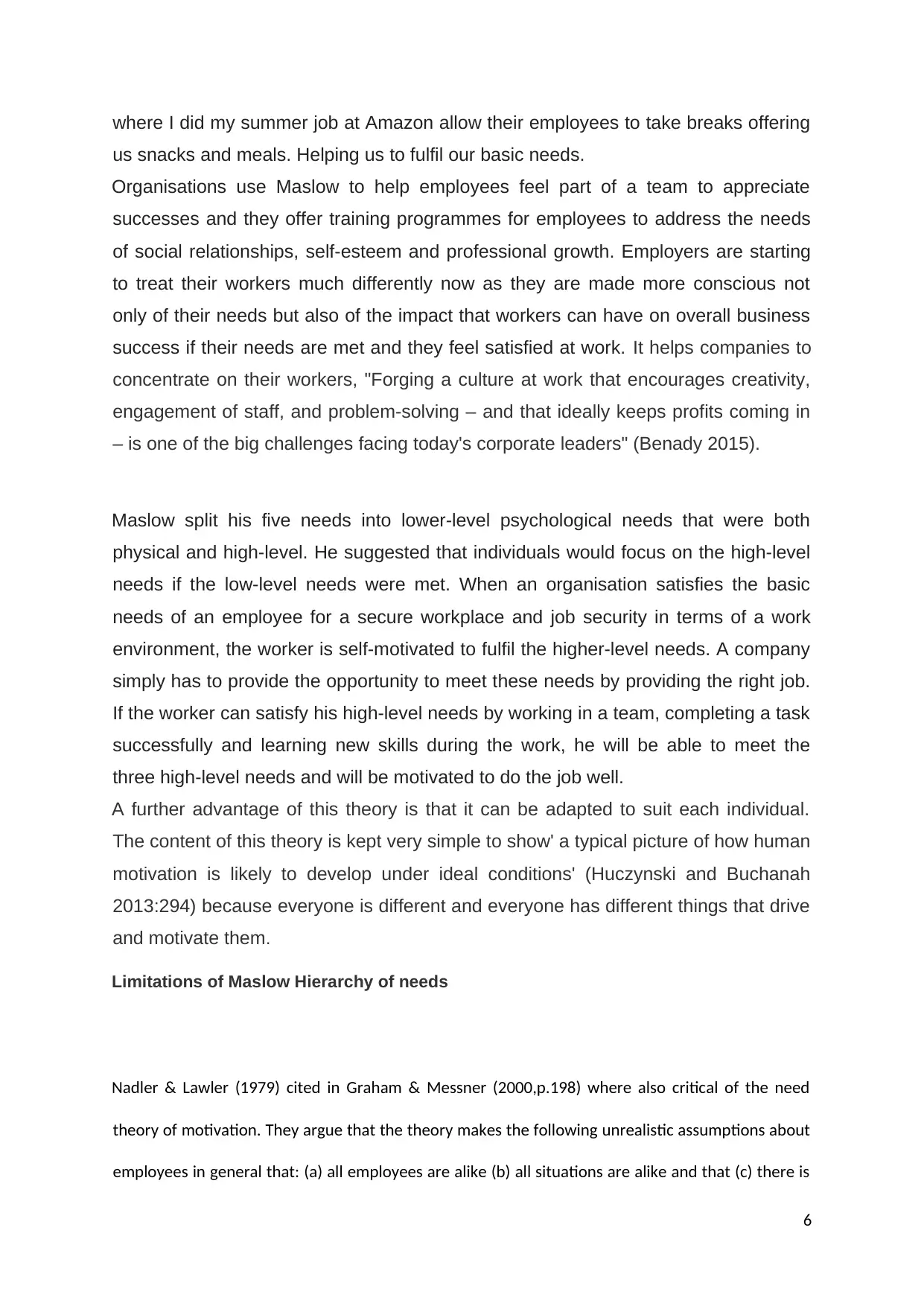
where I did my summer job at Amazon allow their employees to take breaks offering
us snacks and meals. Helping us to fulfil our basic needs.
Organisations use Maslow to help employees feel part of a team to appreciate
successes and they offer training programmes for employees to address the needs
of social relationships, self-esteem and professional growth. Employers are starting
to treat their workers much differently now as they are made more conscious not
only of their needs but also of the impact that workers can have on overall business
success if their needs are met and they feel satisfied at work. It helps companies to
concentrate on their workers, "Forging a culture at work that encourages creativity,
engagement of staff, and problem-solving – and that ideally keeps profits coming in
– is one of the big challenges facing today's corporate leaders" (Benady 2015).
Maslow split his five needs into lower-level psychological needs that were both
physical and high-level. He suggested that individuals would focus on the high-level
needs if the low-level needs were met. When an organisation satisfies the basic
needs of an employee for a secure workplace and job security in terms of a work
environment, the worker is self-motivated to fulfil the higher-level needs. A company
simply has to provide the opportunity to meet these needs by providing the right job.
If the worker can satisfy his high-level needs by working in a team, completing a task
successfully and learning new skills during the work, he will be able to meet the
three high-level needs and will be motivated to do the job well.
A further advantage of this theory is that it can be adapted to suit each individual.
The content of this theory is kept very simple to show' a typical picture of how human
motivation is likely to develop under ideal conditions' (Huczynski and Buchanah
2013:294) because everyone is different and everyone has different things that drive
and motivate them.
Limitations of Maslow Hierarchy of needs
Nadler & Lawler (1979) cited in Graham & Messner (2000,p.198) where also critical of the need
theory of motivation. They argue that the theory makes the following unrealistic assumptions about
employees in general that: (a) all employees are alike (b) all situations are alike and that (c) there is
6
us snacks and meals. Helping us to fulfil our basic needs.
Organisations use Maslow to help employees feel part of a team to appreciate
successes and they offer training programmes for employees to address the needs
of social relationships, self-esteem and professional growth. Employers are starting
to treat their workers much differently now as they are made more conscious not
only of their needs but also of the impact that workers can have on overall business
success if their needs are met and they feel satisfied at work. It helps companies to
concentrate on their workers, "Forging a culture at work that encourages creativity,
engagement of staff, and problem-solving – and that ideally keeps profits coming in
– is one of the big challenges facing today's corporate leaders" (Benady 2015).
Maslow split his five needs into lower-level psychological needs that were both
physical and high-level. He suggested that individuals would focus on the high-level
needs if the low-level needs were met. When an organisation satisfies the basic
needs of an employee for a secure workplace and job security in terms of a work
environment, the worker is self-motivated to fulfil the higher-level needs. A company
simply has to provide the opportunity to meet these needs by providing the right job.
If the worker can satisfy his high-level needs by working in a team, completing a task
successfully and learning new skills during the work, he will be able to meet the
three high-level needs and will be motivated to do the job well.
A further advantage of this theory is that it can be adapted to suit each individual.
The content of this theory is kept very simple to show' a typical picture of how human
motivation is likely to develop under ideal conditions' (Huczynski and Buchanah
2013:294) because everyone is different and everyone has different things that drive
and motivate them.
Limitations of Maslow Hierarchy of needs
Nadler & Lawler (1979) cited in Graham & Messner (2000,p.198) where also critical of the need
theory of motivation. They argue that the theory makes the following unrealistic assumptions about
employees in general that: (a) all employees are alike (b) all situations are alike and that (c) there is
6
⊘ This is a preview!⊘
Do you want full access?
Subscribe today to unlock all pages.

Trusted by 1+ million students worldwide
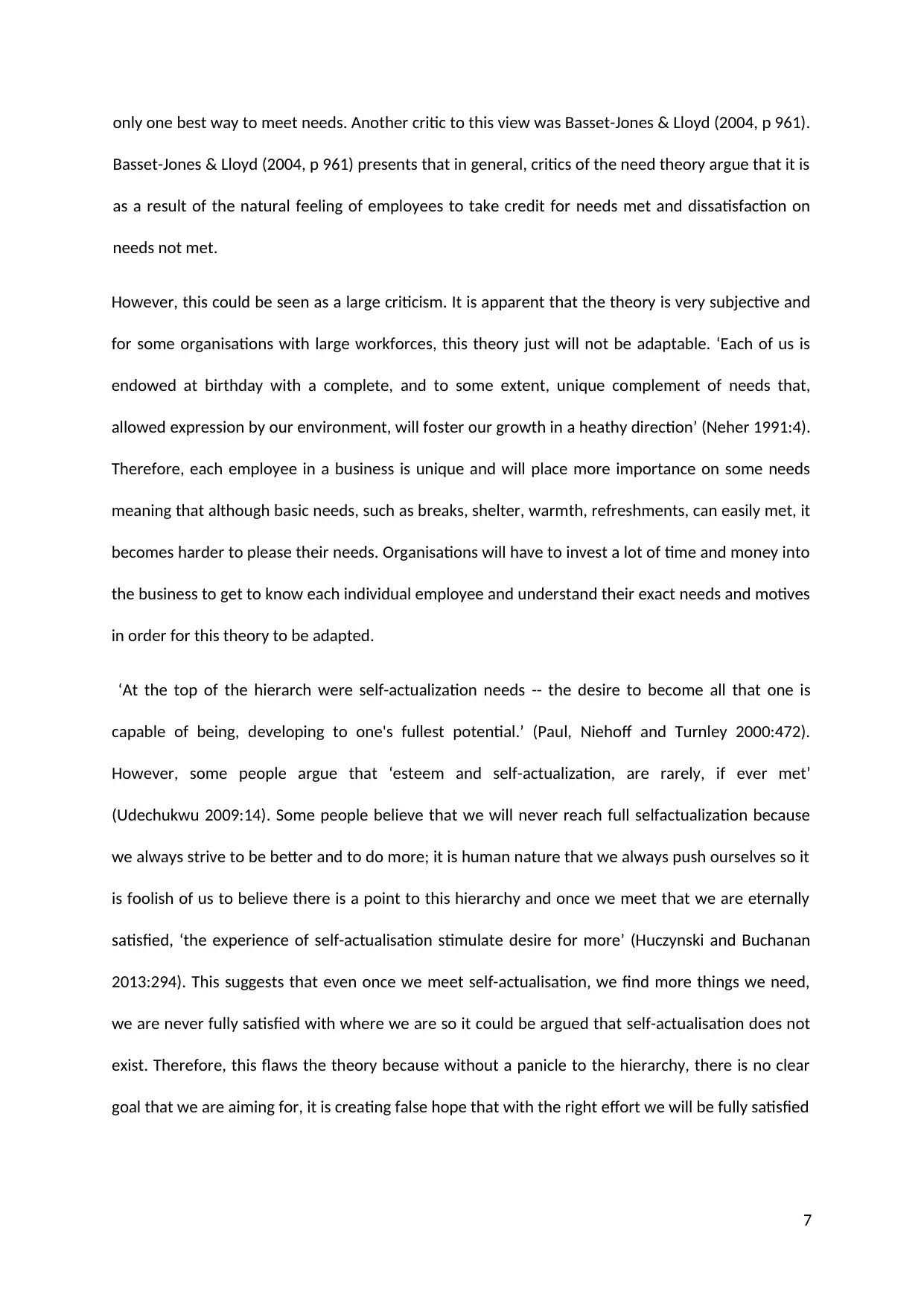
only one best way to meet needs. Another critic to this view was Basset-Jones & Lloyd (2004, p 961).
Basset-Jones & Lloyd (2004, p 961) presents that in general, critics of the need theory argue that it is
as a result of the natural feeling of employees to take credit for needs met and dissatisfaction on
needs not met.
However, this could be seen as a large criticism. It is apparent that the theory is very subjective and
for some organisations with large workforces, this theory just will not be adaptable. ‘Each of us is
endowed at birthday with a complete, and to some extent, unique complement of needs that,
allowed expression by our environment, will foster our growth in a heathy direction’ (Neher 1991:4).
Therefore, each employee in a business is unique and will place more importance on some needs
meaning that although basic needs, such as breaks, shelter, warmth, refreshments, can easily met, it
becomes harder to please their needs. Organisations will have to invest a lot of time and money into
the business to get to know each individual employee and understand their exact needs and motives
in order for this theory to be adapted.
‘At the top of the hierarch were self-actualization needs -- the desire to become all that one is
capable of being, developing to one's fullest potential.’ (Paul, Niehoff and Turnley 2000:472).
However, some people argue that ‘esteem and self-actualization, are rarely, if ever met’
(Udechukwu 2009:14). Some people believe that we will never reach full selfactualization because
we always strive to be better and to do more; it is human nature that we always push ourselves so it
is foolish of us to believe there is a point to this hierarchy and once we meet that we are eternally
satisfied, ‘the experience of self-actualisation stimulate desire for more’ (Huczynski and Buchanan
2013:294). This suggests that even once we meet self-actualisation, we find more things we need,
we are never fully satisfied with where we are so it could be argued that self-actualisation does not
exist. Therefore, this flaws the theory because without a panicle to the hierarchy, there is no clear
goal that we are aiming for, it is creating false hope that with the right effort we will be fully satisfied
7
Basset-Jones & Lloyd (2004, p 961) presents that in general, critics of the need theory argue that it is
as a result of the natural feeling of employees to take credit for needs met and dissatisfaction on
needs not met.
However, this could be seen as a large criticism. It is apparent that the theory is very subjective and
for some organisations with large workforces, this theory just will not be adaptable. ‘Each of us is
endowed at birthday with a complete, and to some extent, unique complement of needs that,
allowed expression by our environment, will foster our growth in a heathy direction’ (Neher 1991:4).
Therefore, each employee in a business is unique and will place more importance on some needs
meaning that although basic needs, such as breaks, shelter, warmth, refreshments, can easily met, it
becomes harder to please their needs. Organisations will have to invest a lot of time and money into
the business to get to know each individual employee and understand their exact needs and motives
in order for this theory to be adapted.
‘At the top of the hierarch were self-actualization needs -- the desire to become all that one is
capable of being, developing to one's fullest potential.’ (Paul, Niehoff and Turnley 2000:472).
However, some people argue that ‘esteem and self-actualization, are rarely, if ever met’
(Udechukwu 2009:14). Some people believe that we will never reach full selfactualization because
we always strive to be better and to do more; it is human nature that we always push ourselves so it
is foolish of us to believe there is a point to this hierarchy and once we meet that we are eternally
satisfied, ‘the experience of self-actualisation stimulate desire for more’ (Huczynski and Buchanan
2013:294). This suggests that even once we meet self-actualisation, we find more things we need,
we are never fully satisfied with where we are so it could be argued that self-actualisation does not
exist. Therefore, this flaws the theory because without a panicle to the hierarchy, there is no clear
goal that we are aiming for, it is creating false hope that with the right effort we will be fully satisfied
7
Paraphrase This Document
Need a fresh take? Get an instant paraphrase of this document with our AI Paraphraser
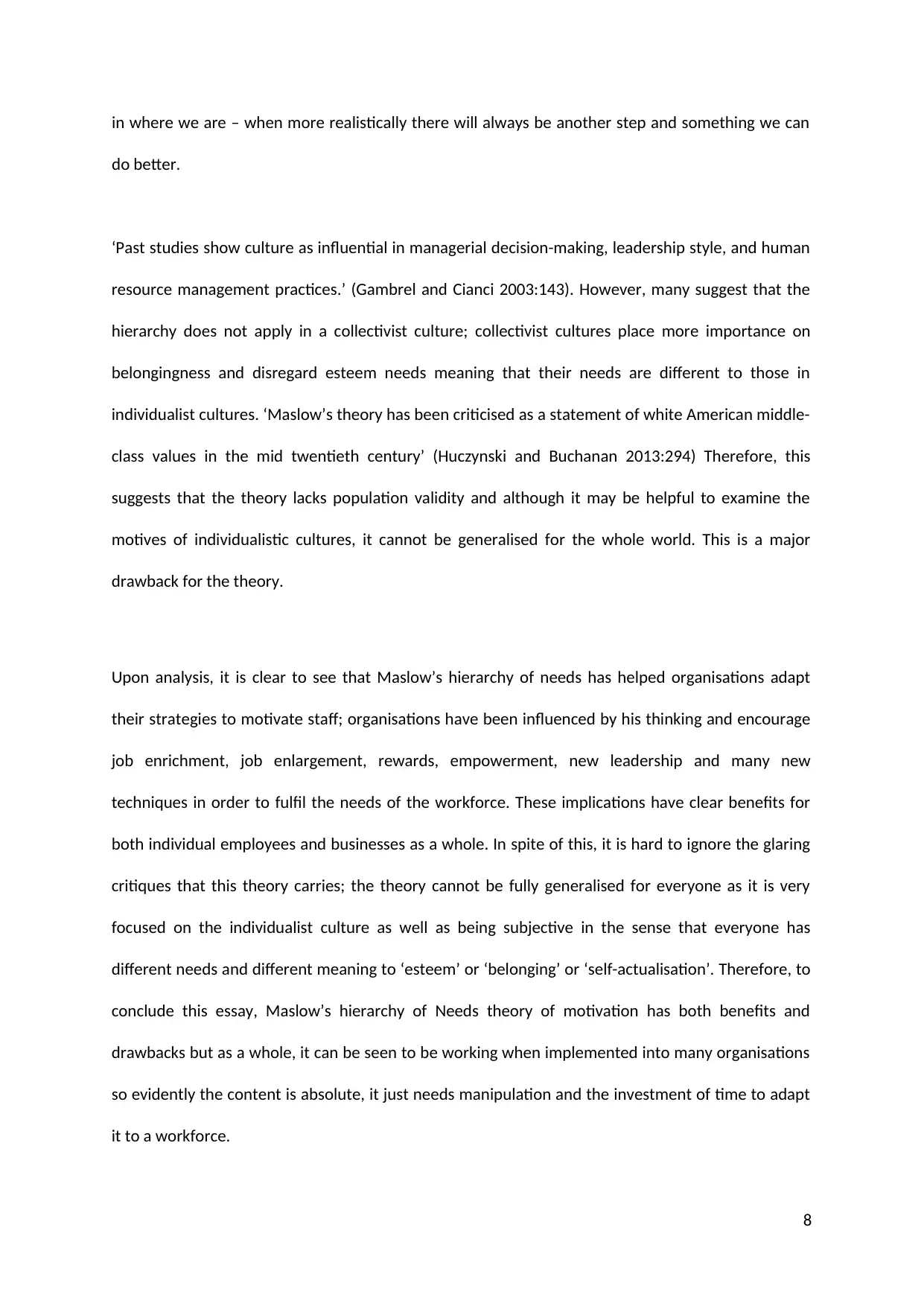
in where we are – when more realistically there will always be another step and something we can
do better.
‘Past studies show culture as influential in managerial decision-making, leadership style, and human
resource management practices.’ (Gambrel and Cianci 2003:143). However, many suggest that the
hierarchy does not apply in a collectivist culture; collectivist cultures place more importance on
belongingness and disregard esteem needs meaning that their needs are different to those in
individualist cultures. ‘Maslow’s theory has been criticised as a statement of white American middle-
class values in the mid twentieth century’ (Huczynski and Buchanan 2013:294) Therefore, this
suggests that the theory lacks population validity and although it may be helpful to examine the
motives of individualistic cultures, it cannot be generalised for the whole world. This is a major
drawback for the theory.
Upon analysis, it is clear to see that Maslow’s hierarchy of needs has helped organisations adapt
their strategies to motivate staff; organisations have been influenced by his thinking and encourage
job enrichment, job enlargement, rewards, empowerment, new leadership and many new
techniques in order to fulfil the needs of the workforce. These implications have clear benefits for
both individual employees and businesses as a whole. In spite of this, it is hard to ignore the glaring
critiques that this theory carries; the theory cannot be fully generalised for everyone as it is very
focused on the individualist culture as well as being subjective in the sense that everyone has
different needs and different meaning to ‘esteem’ or ‘belonging’ or ‘self-actualisation’. Therefore, to
conclude this essay, Maslow’s hierarchy of Needs theory of motivation has both benefits and
drawbacks but as a whole, it can be seen to be working when implemented into many organisations
so evidently the content is absolute, it just needs manipulation and the investment of time to adapt
it to a workforce.
8
do better.
‘Past studies show culture as influential in managerial decision-making, leadership style, and human
resource management practices.’ (Gambrel and Cianci 2003:143). However, many suggest that the
hierarchy does not apply in a collectivist culture; collectivist cultures place more importance on
belongingness and disregard esteem needs meaning that their needs are different to those in
individualist cultures. ‘Maslow’s theory has been criticised as a statement of white American middle-
class values in the mid twentieth century’ (Huczynski and Buchanan 2013:294) Therefore, this
suggests that the theory lacks population validity and although it may be helpful to examine the
motives of individualistic cultures, it cannot be generalised for the whole world. This is a major
drawback for the theory.
Upon analysis, it is clear to see that Maslow’s hierarchy of needs has helped organisations adapt
their strategies to motivate staff; organisations have been influenced by his thinking and encourage
job enrichment, job enlargement, rewards, empowerment, new leadership and many new
techniques in order to fulfil the needs of the workforce. These implications have clear benefits for
both individual employees and businesses as a whole. In spite of this, it is hard to ignore the glaring
critiques that this theory carries; the theory cannot be fully generalised for everyone as it is very
focused on the individualist culture as well as being subjective in the sense that everyone has
different needs and different meaning to ‘esteem’ or ‘belonging’ or ‘self-actualisation’. Therefore, to
conclude this essay, Maslow’s hierarchy of Needs theory of motivation has both benefits and
drawbacks but as a whole, it can be seen to be working when implemented into many organisations
so evidently the content is absolute, it just needs manipulation and the investment of time to adapt
it to a workforce.
8
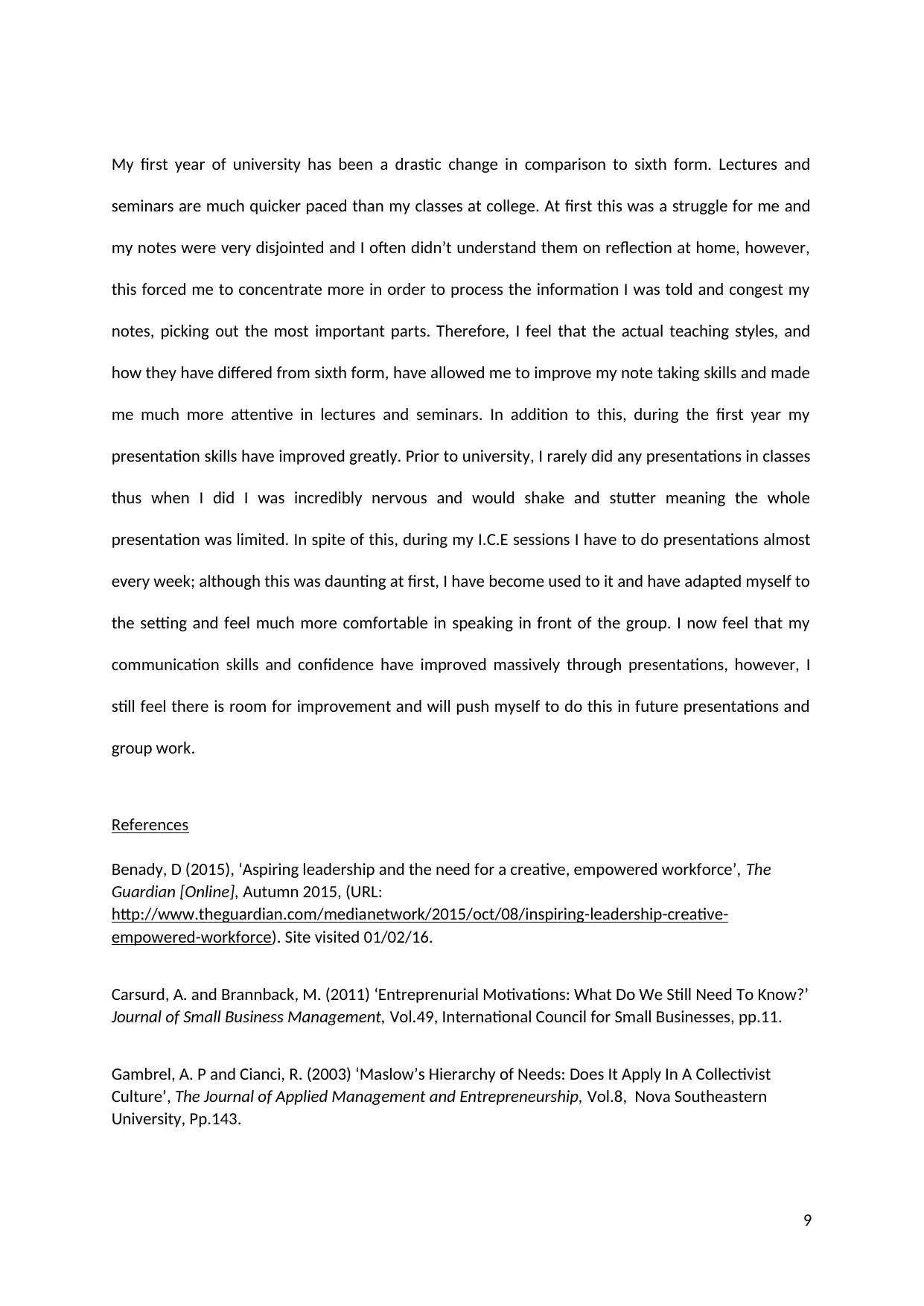
My first year of university has been a drastic change in comparison to sixth form. Lectures and
seminars are much quicker paced than my classes at college. At first this was a struggle for me and
my notes were very disjointed and I often didn’t understand them on reflection at home, however,
this forced me to concentrate more in order to process the information I was told and congest my
notes, picking out the most important parts. Therefore, I feel that the actual teaching styles, and
how they have differed from sixth form, have allowed me to improve my note taking skills and made
me much more attentive in lectures and seminars. In addition to this, during the first year my
presentation skills have improved greatly. Prior to university, I rarely did any presentations in classes
thus when I did I was incredibly nervous and would shake and stutter meaning the whole
presentation was limited. In spite of this, during my I.C.E sessions I have to do presentations almost
every week; although this was daunting at first, I have become used to it and have adapted myself to
the setting and feel much more comfortable in speaking in front of the group. I now feel that my
communication skills and confidence have improved massively through presentations, however, I
still feel there is room for improvement and will push myself to do this in future presentations and
group work.
References
Benady, D (2015), ‘Aspiring leadership and the need for a creative, empowered workforce’, The
Guardian [Online], Autumn 2015, (URL:
http://www.theguardian.com/medianetwork/2015/oct/08/inspiring-leadership-creative-
empowered-workforce). Site visited 01/02/16.
Carsurd, A. and Brannback, M. (2011) ‘Entreprenurial Motivations: What Do We Still Need To Know?’
Journal of Small Business Management, Vol.49, International Council for Small Businesses, pp.11.
Gambrel, A. P and Cianci, R. (2003) ‘Maslow’s Hierarchy of Needs: Does It Apply In A Collectivist
Culture’, The Journal of Applied Management and Entrepreneurship, Vol.8, Nova Southeastern
University, Pp.143.
9
seminars are much quicker paced than my classes at college. At first this was a struggle for me and
my notes were very disjointed and I often didn’t understand them on reflection at home, however,
this forced me to concentrate more in order to process the information I was told and congest my
notes, picking out the most important parts. Therefore, I feel that the actual teaching styles, and
how they have differed from sixth form, have allowed me to improve my note taking skills and made
me much more attentive in lectures and seminars. In addition to this, during the first year my
presentation skills have improved greatly. Prior to university, I rarely did any presentations in classes
thus when I did I was incredibly nervous and would shake and stutter meaning the whole
presentation was limited. In spite of this, during my I.C.E sessions I have to do presentations almost
every week; although this was daunting at first, I have become used to it and have adapted myself to
the setting and feel much more comfortable in speaking in front of the group. I now feel that my
communication skills and confidence have improved massively through presentations, however, I
still feel there is room for improvement and will push myself to do this in future presentations and
group work.
References
Benady, D (2015), ‘Aspiring leadership and the need for a creative, empowered workforce’, The
Guardian [Online], Autumn 2015, (URL:
http://www.theguardian.com/medianetwork/2015/oct/08/inspiring-leadership-creative-
empowered-workforce). Site visited 01/02/16.
Carsurd, A. and Brannback, M. (2011) ‘Entreprenurial Motivations: What Do We Still Need To Know?’
Journal of Small Business Management, Vol.49, International Council for Small Businesses, pp.11.
Gambrel, A. P and Cianci, R. (2003) ‘Maslow’s Hierarchy of Needs: Does It Apply In A Collectivist
Culture’, The Journal of Applied Management and Entrepreneurship, Vol.8, Nova Southeastern
University, Pp.143.
9
⊘ This is a preview!⊘
Do you want full access?
Subscribe today to unlock all pages.

Trusted by 1+ million students worldwide
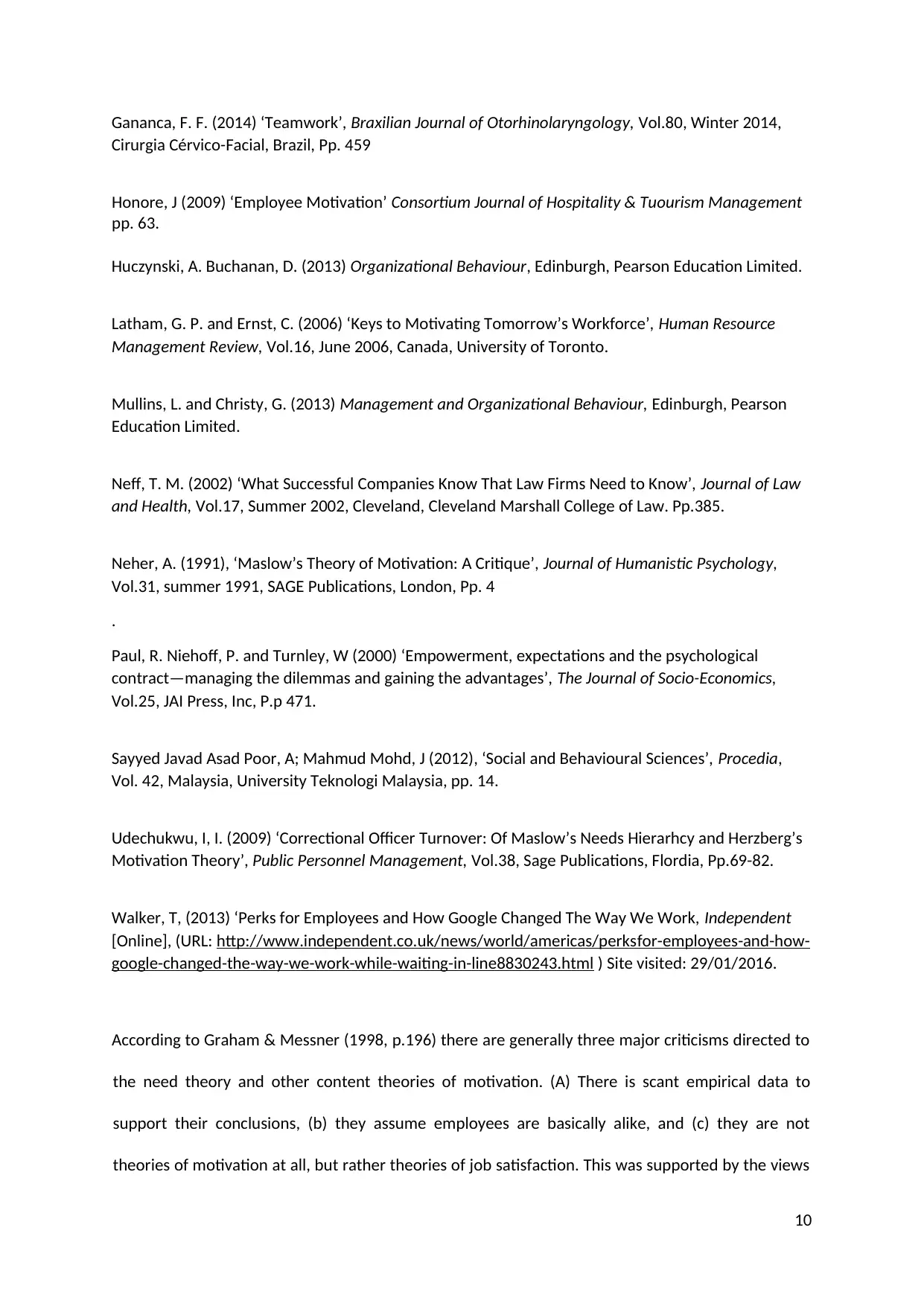
Gananca, F. F. (2014) ‘Teamwork’, Braxilian Journal of Otorhinolaryngology, Vol.80, Winter 2014,
Cirurgia Cérvico-Facial, Brazil, Pp. 459
Honore, J (2009) ‘Employee Motivation’ Consortium Journal of Hospitality & Tuourism Management
pp. 63.
Huczynski, A. Buchanan, D. (2013) Organizational Behaviour, Edinburgh, Pearson Education Limited.
Latham, G. P. and Ernst, C. (2006) ‘Keys to Motivating Tomorrow’s Workforce’, Human Resource
Management Review, Vol.16, June 2006, Canada, University of Toronto.
Mullins, L. and Christy, G. (2013) Management and Organizational Behaviour, Edinburgh, Pearson
Education Limited.
Neff, T. M. (2002) ‘What Successful Companies Know That Law Firms Need to Know’, Journal of Law
and Health, Vol.17, Summer 2002, Cleveland, Cleveland Marshall College of Law. Pp.385.
Neher, A. (1991), ‘Maslow’s Theory of Motivation: A Critique’, Journal of Humanistic Psychology,
Vol.31, summer 1991, SAGE Publications, London, Pp. 4
.
Paul, R. Niehoff, P. and Turnley, W (2000) ‘Empowerment, expectations and the psychological
contract—managing the dilemmas and gaining the advantages’, The Journal of Socio-Economics,
Vol.25, JAI Press, Inc, P.p 471.
Sayyed Javad Asad Poor, A; Mahmud Mohd, J (2012), ‘Social and Behavioural Sciences’, Procedia,
Vol. 42, Malaysia, University Teknologi Malaysia, pp. 14.
Udechukwu, I, I. (2009) ‘Correctional Officer Turnover: Of Maslow’s Needs Hierarhcy and Herzberg’s
Motivation Theory’, Public Personnel Management, Vol.38, Sage Publications, Flordia, Pp.69-82.
Walker, T, (2013) ‘Perks for Employees and How Google Changed The Way We Work, Independent
[Online], (URL: http://www.independent.co.uk/news/world/americas/perksfor-employees-and-how-
google-changed-the-way-we-work-while-waiting-in-line8830243.html ) Site visited: 29/01/2016.
According to Graham & Messner (1998, p.196) there are generally three major criticisms directed to
the need theory and other content theories of motivation. (A) There is scant empirical data to
support their conclusions, (b) they assume employees are basically alike, and (c) they are not
theories of motivation at all, but rather theories of job satisfaction. This was supported by the views
10
Cirurgia Cérvico-Facial, Brazil, Pp. 459
Honore, J (2009) ‘Employee Motivation’ Consortium Journal of Hospitality & Tuourism Management
pp. 63.
Huczynski, A. Buchanan, D. (2013) Organizational Behaviour, Edinburgh, Pearson Education Limited.
Latham, G. P. and Ernst, C. (2006) ‘Keys to Motivating Tomorrow’s Workforce’, Human Resource
Management Review, Vol.16, June 2006, Canada, University of Toronto.
Mullins, L. and Christy, G. (2013) Management and Organizational Behaviour, Edinburgh, Pearson
Education Limited.
Neff, T. M. (2002) ‘What Successful Companies Know That Law Firms Need to Know’, Journal of Law
and Health, Vol.17, Summer 2002, Cleveland, Cleveland Marshall College of Law. Pp.385.
Neher, A. (1991), ‘Maslow’s Theory of Motivation: A Critique’, Journal of Humanistic Psychology,
Vol.31, summer 1991, SAGE Publications, London, Pp. 4
.
Paul, R. Niehoff, P. and Turnley, W (2000) ‘Empowerment, expectations and the psychological
contract—managing the dilemmas and gaining the advantages’, The Journal of Socio-Economics,
Vol.25, JAI Press, Inc, P.p 471.
Sayyed Javad Asad Poor, A; Mahmud Mohd, J (2012), ‘Social and Behavioural Sciences’, Procedia,
Vol. 42, Malaysia, University Teknologi Malaysia, pp. 14.
Udechukwu, I, I. (2009) ‘Correctional Officer Turnover: Of Maslow’s Needs Hierarhcy and Herzberg’s
Motivation Theory’, Public Personnel Management, Vol.38, Sage Publications, Flordia, Pp.69-82.
Walker, T, (2013) ‘Perks for Employees and How Google Changed The Way We Work, Independent
[Online], (URL: http://www.independent.co.uk/news/world/americas/perksfor-employees-and-how-
google-changed-the-way-we-work-while-waiting-in-line8830243.html ) Site visited: 29/01/2016.
According to Graham & Messner (1998, p.196) there are generally three major criticisms directed to
the need theory and other content theories of motivation. (A) There is scant empirical data to
support their conclusions, (b) they assume employees are basically alike, and (c) they are not
theories of motivation at all, but rather theories of job satisfaction. This was supported by the views
10
Paraphrase This Document
Need a fresh take? Get an instant paraphrase of this document with our AI Paraphraser
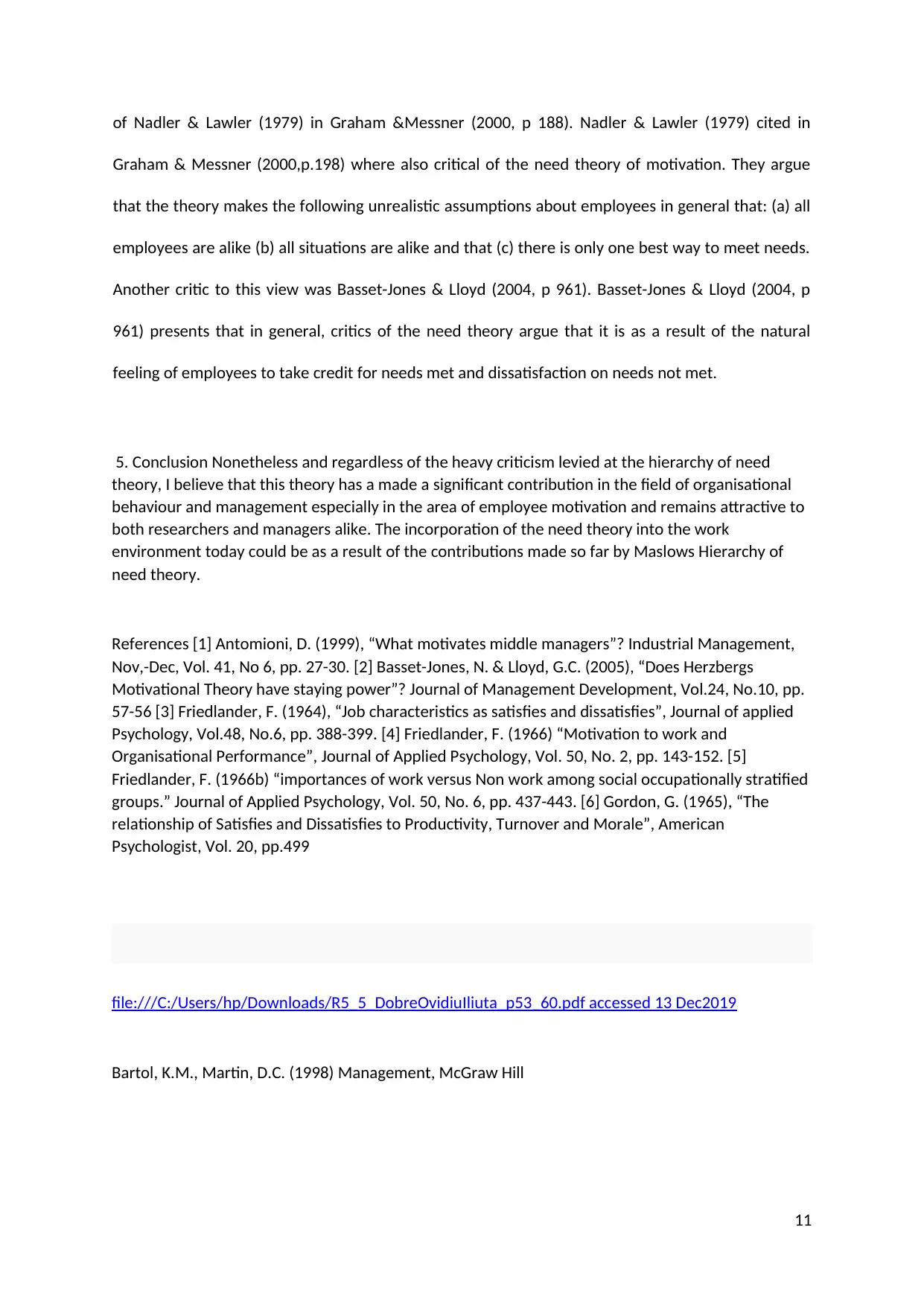
of Nadler & Lawler (1979) in Graham &Messner (2000, p 188). Nadler & Lawler (1979) cited in
Graham & Messner (2000,p.198) where also critical of the need theory of motivation. They argue
that the theory makes the following unrealistic assumptions about employees in general that: (a) all
employees are alike (b) all situations are alike and that (c) there is only one best way to meet needs.
Another critic to this view was Basset-Jones & Lloyd (2004, p 961). Basset-Jones & Lloyd (2004, p
961) presents that in general, critics of the need theory argue that it is as a result of the natural
feeling of employees to take credit for needs met and dissatisfaction on needs not met.
5. Conclusion Nonetheless and regardless of the heavy criticism levied at the hierarchy of need
theory, I believe that this theory has a made a significant contribution in the field of organisational
behaviour and management especially in the area of employee motivation and remains attractive to
both researchers and managers alike. The incorporation of the need theory into the work
environment today could be as a result of the contributions made so far by Maslows Hierarchy of
need theory.
References [1] Antomioni, D. (1999), “What motivates middle managers”? Industrial Management,
Nov,-Dec, Vol. 41, No 6, pp. 27-30. [2] Basset-Jones, N. & Lloyd, G.C. (2005), “Does Herzbergs
Motivational Theory have staying power”? Journal of Management Development, Vol.24, No.10, pp.
57-56 [3] Friedlander, F. (1964), “Job characteristics as satisfies and dissatisfies”, Journal of applied
Psychology, Vol.48, No.6, pp. 388-399. [4] Friedlander, F. (1966) “Motivation to work and
Organisational Performance”, Journal of Applied Psychology, Vol. 50, No. 2, pp. 143-152. [5]
Friedlander, F. (1966b) “importances of work versus Non work among social occupationally stratified
groups.” Journal of Applied Psychology, Vol. 50, No. 6, pp. 437-443. [6] Gordon, G. (1965), “The
relationship of Satisfies and Dissatisfies to Productivity, Turnover and Morale”, American
Psychologist, Vol. 20, pp.499
theories of motivation
file:///C:/Users/hp/Downloads/R5_5_DobreOvidiuIliuta_p53_60.pdf accessed 13 Dec2019
Bartol, K.M., Martin, D.C. (1998) Management, McGraw Hill
11
Graham & Messner (2000,p.198) where also critical of the need theory of motivation. They argue
that the theory makes the following unrealistic assumptions about employees in general that: (a) all
employees are alike (b) all situations are alike and that (c) there is only one best way to meet needs.
Another critic to this view was Basset-Jones & Lloyd (2004, p 961). Basset-Jones & Lloyd (2004, p
961) presents that in general, critics of the need theory argue that it is as a result of the natural
feeling of employees to take credit for needs met and dissatisfaction on needs not met.
5. Conclusion Nonetheless and regardless of the heavy criticism levied at the hierarchy of need
theory, I believe that this theory has a made a significant contribution in the field of organisational
behaviour and management especially in the area of employee motivation and remains attractive to
both researchers and managers alike. The incorporation of the need theory into the work
environment today could be as a result of the contributions made so far by Maslows Hierarchy of
need theory.
References [1] Antomioni, D. (1999), “What motivates middle managers”? Industrial Management,
Nov,-Dec, Vol. 41, No 6, pp. 27-30. [2] Basset-Jones, N. & Lloyd, G.C. (2005), “Does Herzbergs
Motivational Theory have staying power”? Journal of Management Development, Vol.24, No.10, pp.
57-56 [3] Friedlander, F. (1964), “Job characteristics as satisfies and dissatisfies”, Journal of applied
Psychology, Vol.48, No.6, pp. 388-399. [4] Friedlander, F. (1966) “Motivation to work and
Organisational Performance”, Journal of Applied Psychology, Vol. 50, No. 2, pp. 143-152. [5]
Friedlander, F. (1966b) “importances of work versus Non work among social occupationally stratified
groups.” Journal of Applied Psychology, Vol. 50, No. 6, pp. 437-443. [6] Gordon, G. (1965), “The
relationship of Satisfies and Dissatisfies to Productivity, Turnover and Morale”, American
Psychologist, Vol. 20, pp.499
theories of motivation
file:///C:/Users/hp/Downloads/R5_5_DobreOvidiuIliuta_p53_60.pdf accessed 13 Dec2019
Bartol, K.M., Martin, D.C. (1998) Management, McGraw Hill
11
1 out of 11
Related Documents
Your All-in-One AI-Powered Toolkit for Academic Success.
+13062052269
info@desklib.com
Available 24*7 on WhatsApp / Email
![[object Object]](/_next/static/media/star-bottom.7253800d.svg)
Unlock your academic potential
Copyright © 2020–2025 A2Z Services. All Rights Reserved. Developed and managed by ZUCOL.




